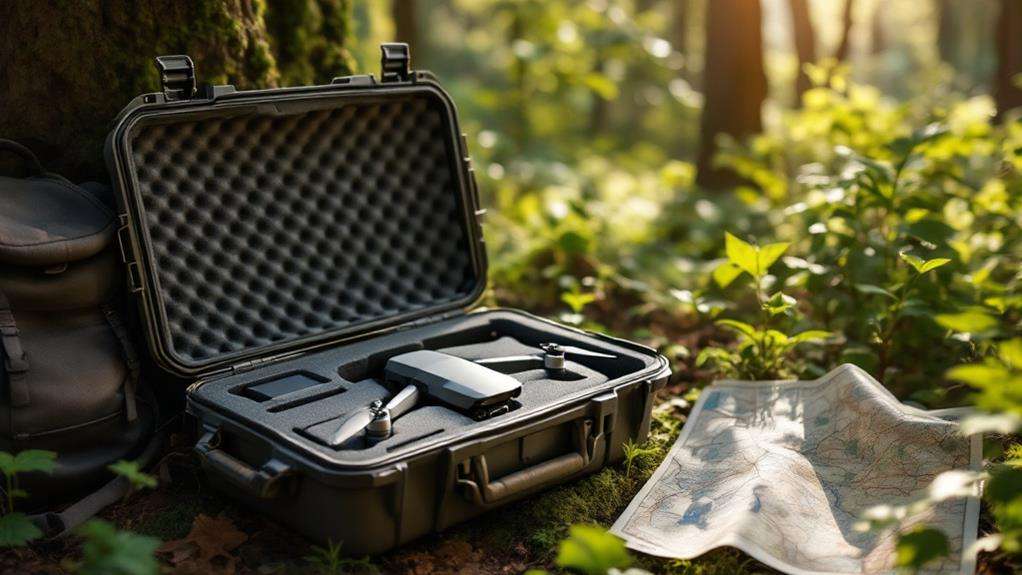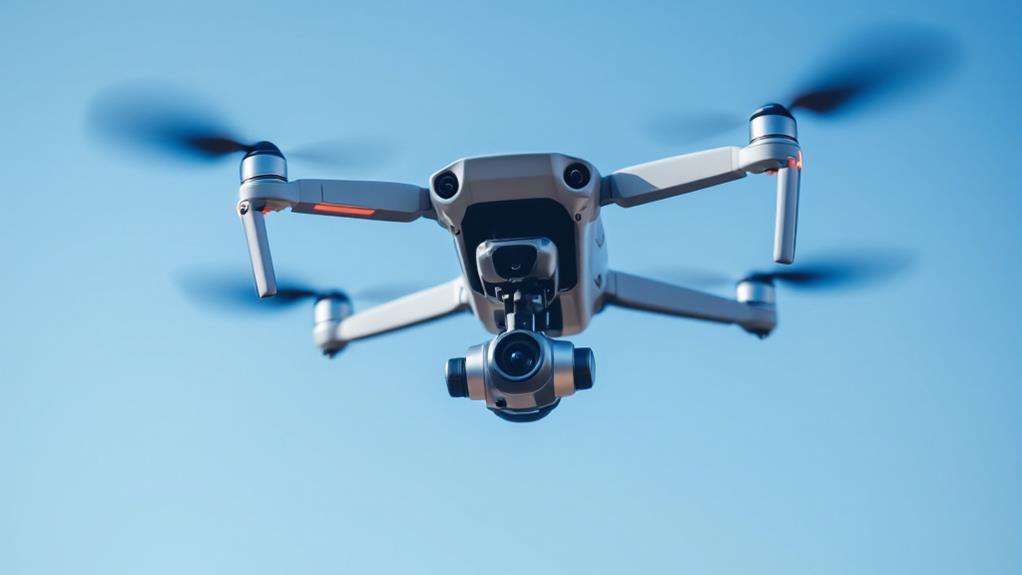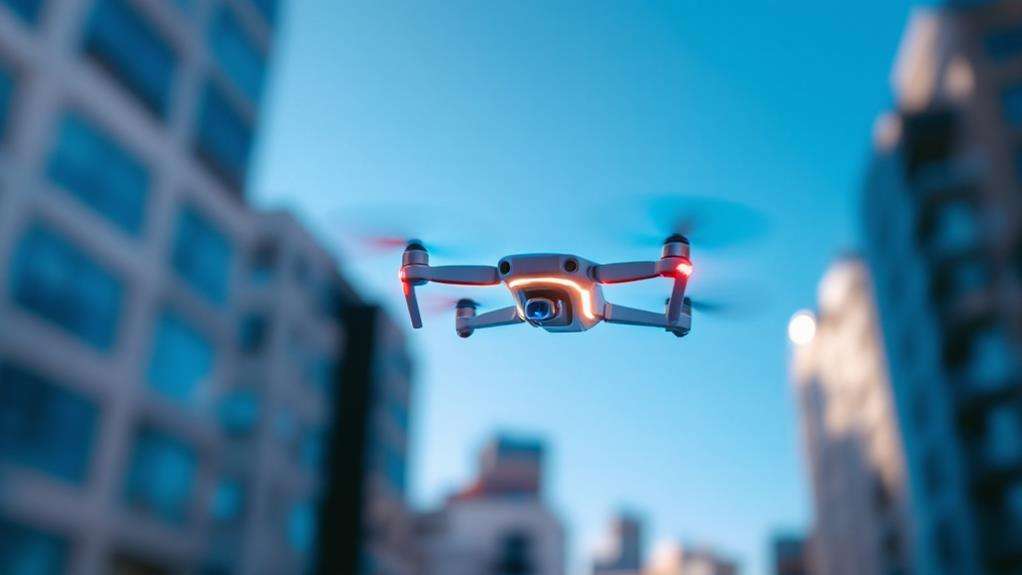Can You Hang Something With a Drone?
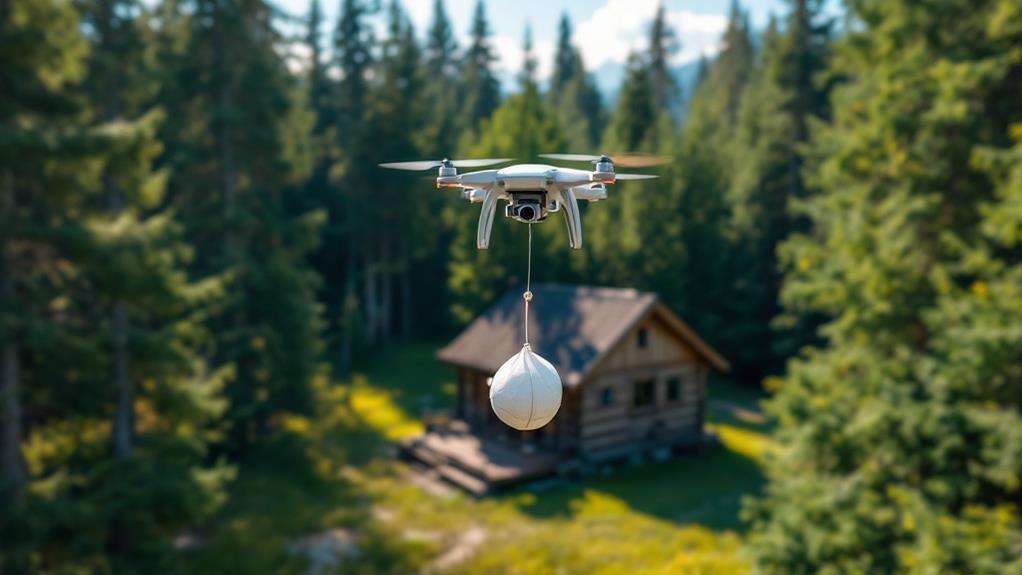
Yes, you can hang items with a drone by taking advantage of its payload capabilities and using the right tools. The DJI AIR 3, for instance, can handle up to 750 grams, making it suitable for hanging tasks. You'll need rigid iron wire hooks and a payload release device to ensure stability and precision. It's important to balance the weight and use an appropriate wire length to minimize swinging. Remember, adhering to regulations is crucial, as is maintaining proper calibration for stable flight. With some careful planning and consideration of these factors, you can achieve more with your drone.
Key Takeaways
- Drones like the DJI AIR 3 can effectively hang items using a payload release mechanism and iron wire hooks.
- The DJI AIR 3 supports payloads up to 750 grams, suitable for hanging lightweight items such as pictures or LED lights.
- Proper equipment, including rigid iron wire hooks and airdropped payload release devices, ensures secure attachment and stability.
- Maintaining wire lengths of 1.8-2 meters minimizes swinging and optimizes drone performance during hanging tasks.
- Adherence to FAA regulations is essential when using drones for hanging tasks to ensure public safety and legal compliance.
Exploring Drone Capabilities
When considering the capabilities of drones, you might be surprised at how versatile these devices have become. Drones like the DJI AIR 3 and MINI 2 are not just for photography or video capturing; they can perform complex hanging tasks too. By utilizing a payload release mechanism, these drones can carry and hang items such as pictures and solar-powered LED lights with remarkable ease. In agricultural innovations, drones are used for precision farming techniques which involve complex payload management similar to hanging tasks. The DJI AIR 3 can handle a payload of up to 750 grams, making it suitable for a wide range of tasks. To ensure secure attachment during flight, a rigid iron wire hook can be constructed. This hook allows for stability and minimizes swinging during transport. The wire connecting the drone to the payload should ideally be between 1.8 to 2 meters long, providing optimal control and performance.
Precision in hook placement is crucial for successful item hanging. You'll need to employ stabilization techniques to maintain the drone's balance and minimize payload movement. These techniques ensure that the payload is attached accurately and securely, reducing the risk of misplacement or damage. With these capabilities, drones are proving to be invaluable tools in performing hanging tasks efficiently and effectively.
Essential Equipment and Tools
Now that you understand drone capabilities, let's focus on the equipment and tools you'll need for successful hanging tasks. As a drone enthusiast, you know that having the right gear can make all the difference. Start with a DJI AIR 3 drone, capable of carrying a 750-gram payload, making it ideal for various hanging heights. To ensure safe and precise payload detachment, invest in an airdropped payload release device. At just $10, it's a small price for reliability and accuracy in your aerial endeavors. Utilizing drones for infrastructure tasks can minimize personnel exposure to hazardous environments, underscoring their versatility in multiple applications.
For constructing sturdy hooks, use rigid iron wire, with a thickness of 1.8-2 mm. This ensures stability when suspending items. For securely attaching your payload, opt for thinner iron wire, around 0.2-0.5 mm. Combine a 40 cm flat skewer stick with padding tape and zip ties to enhance stability and reduce friction during payload transport. This setup is crucial for maintaining control and achieving optimal performance.
Selecting the Right Payload
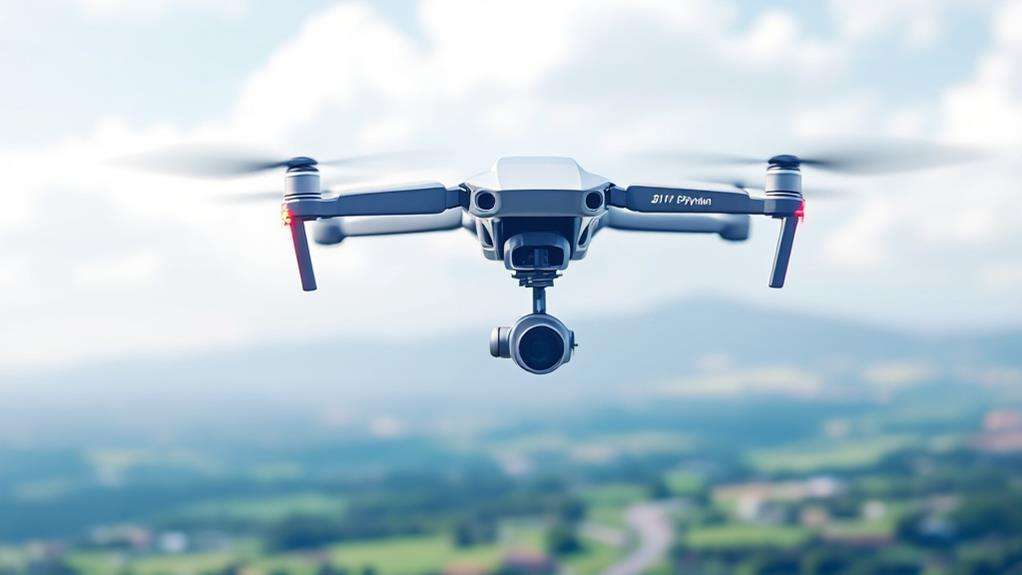
Carefully choosing the right payload is crucial for successful drone hanging tasks. Start by considering lightweight items like pictures or solar-powered LED lights. Drones such as the DJI AIR 3 can manage up to a 750-gram payload, so select items that fit within this capacity. The key to stability lies in securing the payload properly. Iron wire hooks offer excellent attachment points, ensuring your item stays in place during flight.
A crucial aspect is weight distribution. An uneven payload can make your drone wobble and lose control. Use a horizontal stick attachment to create dual attachment points, effectively balancing the weight and preventing sensor interference. This setup also maximizes flight stability.
To further enhance your drone's performance, keep the wire length between the drone and payload around 1.8-2 meters. This length helps minimize swinging, maintaining a smooth flight path.
| Payload Type | Weight (grams) | Stability Tips |
|---|---|---|
| Picture Frame | 500 | Ensure balanced weight distribution |
| LED Light | 200 | Use dual attachment points |
| Decorative Plant | 700 | Secure with iron wire for stability |
Attaching Items Safely
Attaching items safely to a drone is essential for a successful flight and to prevent any accidents. First, ensure that your payload's weight doesn't exceed the drone's lifting capacity. For instance, the DJI AIR 3 can handle up to 750 grams. Overloading the drone can lead to instability and potential crashes. To attach items securely, consider using a rigid iron wire (1.8-2 mm) to create a reliable hook. This wire is strong enough to support the load while minimizing any swinging during flight.
For enhanced payload stability, use a horizontal attachment method. Secure a flat skewer stick, around 40 cm long, horizontally beneath the drone. Tight zip ties and soft padding tape work well for this purpose, preventing the payload from swinging excessively. Additionally, maintain an ideal wire length of 1.8-2 meters between the drone and the payload. This balance is crucial for optimal performance and control.
Before you take off, always calibrate the drone. Calibration accounts for any changes in load, ensuring the center of mass remains close to the drone. This practice enhances stability, making your drone operation safer and more efficient.
Precision Hook Techniques
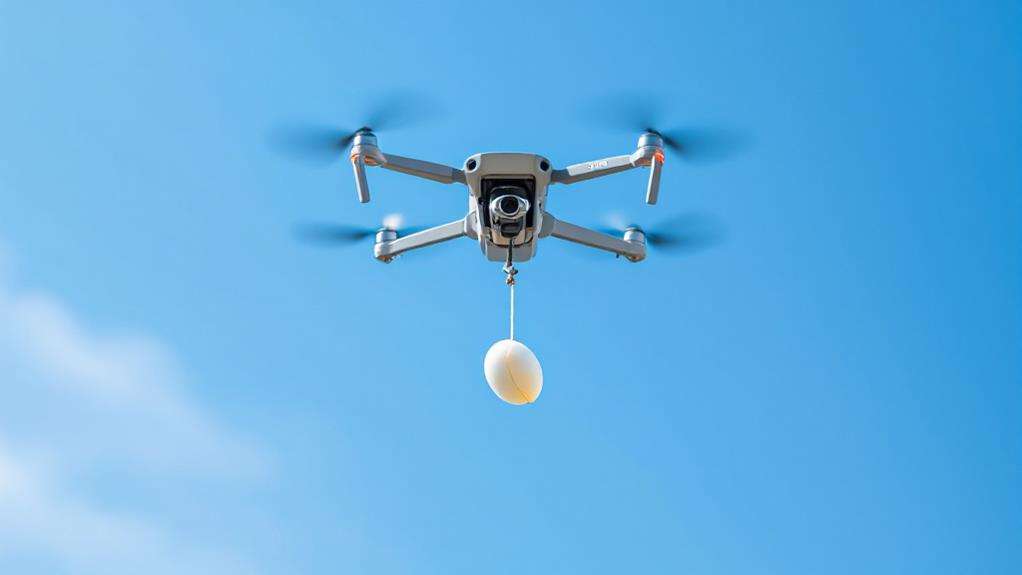
Mastering precision hook techniques is essential when using a drone for specific payload tasks. You need to ensure precision placement of the hook, especially when targeting narrow attachment points like fences or beams. Shortening one side of the hook can enhance control during descent, allowing for greater accuracy. A payload dropper device is crucial for remotely releasing the payload once the hook is perfectly positioned. This ensures you can achieve a clean, efficient drop without manual interference.
The wire length for hook attachment plays a significant role in maintaining stability. Ideally, it should be between 1.8 to 2 meters. This length provides a balance between flexibility and control, helping you manage the hook's position during flight. Vertical adjustments of the drone during its descent can further assist in achieving precise hook placement, minimizing any unwanted swinging or instability.
| Element | Ideal Specification | Purpose |
|---|---|---|
| Hook Attachment | Shortened Side | Enhances control for precision placement |
| Wire Length | 1.8 - 2 meters | Ensures stability and control during flight |
| Payload Dropper Device | Remote Release | Facilitates clean and efficient payload drop |
Using a flat skewer stick on the release mechanism can stabilize the hook, reducing friction for a smooth drop process.
Maintaining Stability During Flight
To maintain stability during flight, it's crucial to keep the drone's center of mass close. Proper weight distribution ensures the drone doesn't have to perform unnecessary compensatory maneuvers, which can complicate flight dynamics and affect stability. When attaching a payload, make sure it's balanced and positioned as close to the drone's center as possible. This helps in maintaining a steadier flight path.
Using a stabilizing horizontal stick with dual attachment points is a smart way to prevent sensor interference, which often leads to instability. The stick also helps distribute the payload evenly, reducing any unwanted swaying. Aim for a wire length between 1.8-2 meters to hang the payload; this range optimizes both stability and performance, keeping your drone flying smoothly.
If the payload is unstable, adding some weight can actually enhance its stability. Pair this with longer, rigid wires to further mitigate swinging during flight. Also, routinely check that your payload release mechanism operates smoothly. Any binding issues during the attachment process can lead to erratic movements, compromising the drone's stability. By following these guidelines, you'll ensure a more stable and controlled flight experience.
Addressing Common Issues
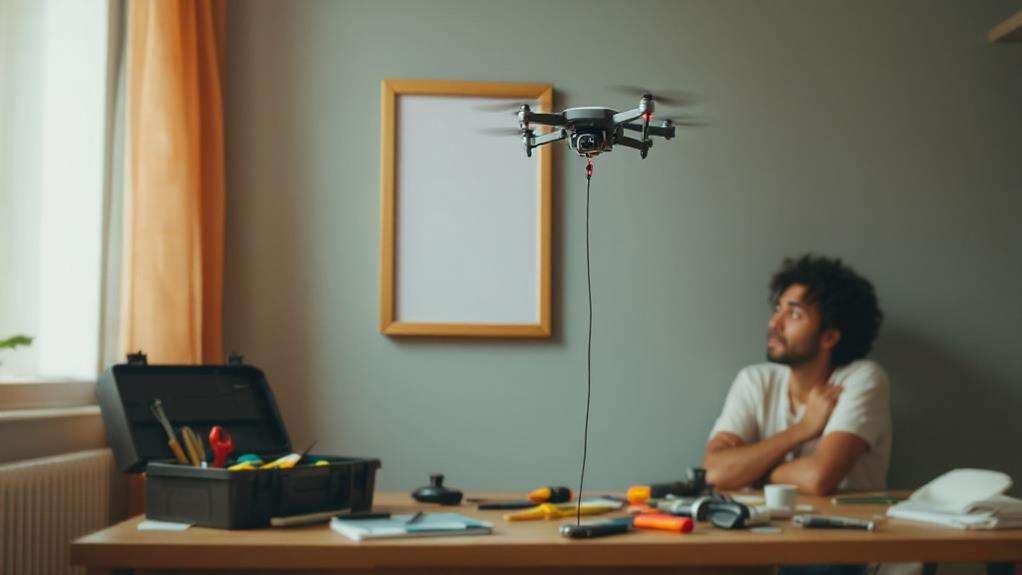
When dealing with the complexities of hanging a payload with a drone, encountering common issues is inevitable. One major problem is an unstable payload. You can resolve this by adding weight or using longer, rigid wires, which help stabilize the payload during flight. To maintain control over the payload's descent, ensure that any stick or attachment is tightly secured. This prevents unwanted swinging, making your operation smoother and more precise.
Another critical aspect is the payload release mechanism. It's essential to check for binding issues to avoid failures during the drop process. A malfunctioning release can lead to incomplete deliveries or even damage, so regular maintenance and testing are crucial.
Adjusting the drone's vertical position can significantly aid in precise hook placement, reducing the chances of the payload swinging during attachment. A well-positioned drone leads to a more controlled and successful operation.
If your drone struggles to lift the payload, consider using a larger drone model. This switch can provide the necessary power and support, ensuring your drone can manage the task effectively. Alternatively, opting for a lighter attachment can also alleviate lifting issues, enhancing overall performance.
Understanding Weight Impact
Understanding the impact of weight on drone operation is crucial for successful payload management. When you're considering hanging something with a drone, it's essential to keep the payloads within the drone's lifting capacity. For instance, the DJI Mini 2 can handle up to 283 grams. Exceeding this can shift the center of mass, leading to loss of stability. It's important to ensure that the center of mass remains close to the drone, as improper weight distribution can cause the drone to become unstable.
To prevent instability, avoid using rigid attachments like heavy wires that can create a pendulum effect. This can cause the drone to crash as it tries to counteract the swinging motion. Instead, distribute the weight evenly to maintain stability. Calibration is also vital when adding any weight. It helps the drone's software adjust to the new load dynamics, ensuring that the drone remains stable. Without proper calibration, the drone might engage in compensatory actions that complicate flight control.
Navigating Legal Guidelines
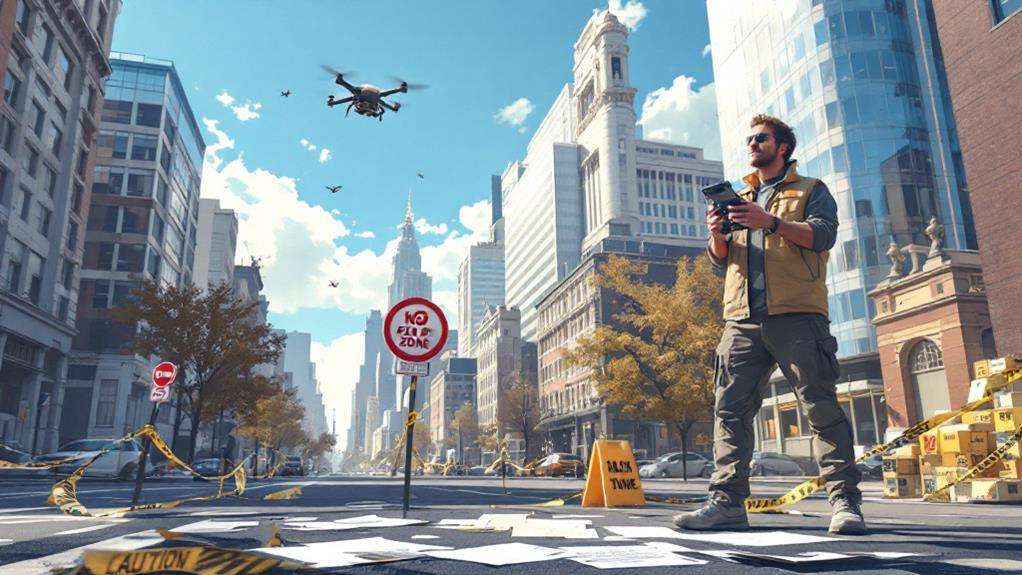
Navigating the legal guidelines for hanging and transporting items with drones is crucial for ensuring compliance and safety. As a drone operator, you must adhere to FAA regulations, which are in place to protect public safety. These guidelines dictate that dropping items from drones is strictly prohibited unless you can ensure safety in both closed sets and general public areas. This means understanding the specific rules that apply to where and how you plan to use your drone.
For those involved in transporting hazardous materials, securing special FAA waivers is essential. The regulations surrounding hazardous materials are stringent, emphasizing the importance of knowing precisely what you're allowed to carry. Failing to comply can lead to significant legal repercussions, so continuous education on the evolving rules is vital.
Public safety entities face even stricter regulations compared to hobbyists, which means staying informed about the latest guidelines and updates is crucial. Misinterpreting drone regulations can land you in legal trouble, highlighting the need for ongoing awareness and education. By keeping up-to-date with FAA regulations and understanding the importance of public safety, you ensure that your drone operations remain compliant and safe.
Real-World Applications
Drones are revolutionizing how we approach tasks that once required cumbersome equipment or risky maneuvers. Whether you're hanging pictures in a lofty atrium or installing solar-powered LED lights on a high facade, drones offer an innovative solution. The DJI AIR 3, with its capability to carry a payload of up to 750 grams, is particularly suited for these hanging tasks. By equipping your drone with a payload attachment crafted from rigid iron wire, you ensure stability as the drone flies to its target.
The magic lies in the airdrop remote payload release device, a cost-effective tool priced around $10. This gadget allows you to precisely position and release your payload, making it ideal for applications where accuracy is paramount. Imagine setting up decorations for an outdoor event or hanging birdhouses at challenging heights—tasks that are now simplified thanks to drone technology.
Real-world applications have demonstrated the effectiveness of drones in practical scenarios, showcasing their versatility. As you explore these possibilities, you'll find that drones not only save time but also enhance safety by eliminating the need for ladders or scaffolding in potentially dangerous situations.

